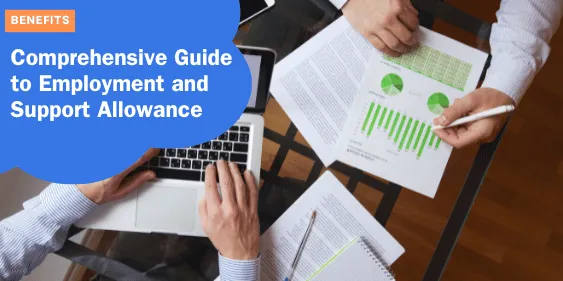Comprehensive Guide to Employment and Support Allowance

Understanding Employment and Support Allowance (ESA)
To fully appreciate Employment and Support Allowance (ESA), it’s essential to first explore New Style ESA.
This benefit is specifically tailored for those who have a history of contributing to National Insurance.
❓ What is New Style ESA?
New Style ESA is available to individuals who have paid sufficient National Insurance contributions within the past two to three years.
It is designed to assist those who are currently unable to work due to illness or disability, provided they have contributed to the system while employed.
Explanation of New Style ESA Based on National Insurance Contributions
New Style ESA is more than just a financial benefit; it reflects your work history.
Each week that you receive this allowance, you also earn National Insurance credits.
These credits are significant as they contribute towards your State Pension and future entitlements.
The amount you receive depends on:
✅ Your age
✅ Your income
✅ Your savings
It is important to note that your partner’s income or savings are not taken into account when determining your eligibility.
Applying for New Style ESA involves a Work Capability Assessment to determine how your health condition or disability affects your ability to work.
Eligibility and Benefits of Employment and Support Allowance (ESA)
Navigating the criteria for ESA can be complex.
Several factors influence your entitlement and the amount of ESA you receive.
It is crucial to understand these aspects, especially in relation to Universal Credit and different types of ESA.
Factors Influencing ESA Benefits
What factors impact your ESA benefits?
✅ Age: ESA is typically available to individuals of working age, generally from 16 up to the State Pension age.
✅ Work Capability: ESA evaluates your ability to work through a Work Capability Assessment, considering your health or disability. Based on this assessment, you will be placed into one of two groups: the work-related activity group or the support group, each with different benefit levels.
✅ Private Pensions: If you receive a private pension, it might affect your ESA. For instance, if your pension exceeds £85 per week, the amount over this threshold could reduce your ESA entitlement. This aspect is particularly relevant for individuals transitioning from employment to claiming benefits due to health issues.
Receiving ESA While Working
Can you continue working while receiving ESA? Yes, under certain conditions.
If you work less than 16 hours a week and earn up to £143 per week after tax, you may still qualify for ESA. This is known as “permitted work,” which allows individuals who can undertake some work to stay connected to the job market without losing their financial support.
✅ Permitted Work: This arrangement supports a gradual re-entry into employment, ensuring that assistance is not abruptly discontinued.
The Application Process for ESA
Applying for ESA involves several steps and requires specific documentation.
✅ Fit Note: You will need a ‘fit note’ (sick note) from your doctor, which confirms that you are unable to work due to health issues or disability.
✅ ESA1 Form: To initiate your claim, you must complete an ESA1 form. This can be done by phone or by downloading the form online.
✅ Work Capability Assessment: After submitting your application, the Department for Work and Pensions (DWP) may require a Work Capability Assessment to evaluate your illness or disability and its impact on your work capacity.
✅ Financial Information: You will need to provide details about your income, savings, and living situation, as these factors influence your ESA eligibility and benefit amount.
✅ Application Timeline: The process may take several weeks, so it is advisable to apply as soon as you are eligible.
✅ Transition from Other Benefits: If you are transitioning from other benefits like Income Support or Jobseeker’s Allowance, additional considerations may apply.
✅ Seek Guidance: Utilize available resources and seek advice to ensure that you are providing all necessary information.
Conclusion and Call-to-Action
Through our exploration of Employment and Support Allowance (ESA), it is evident that this benefit is crucial for individuals dealing with disabilities or health challenges.
ESA not only provides financial support but also facilitates work re-entry and preserves future entitlements through National Insurance credits.
Understanding ESA’s various components is essential for those navigating life with long-term health conditions.
Let’s recap the key points:
We discussed two primary types of ESA: New Style ESA, which is based on National Insurance contributions, and income-related ESA, which considers household finances.
✅ ESA and Universal Credit: The relationship between ESA and Universal Credit was highlighted, illustrating how these benefits work together to offer comprehensive support.
ESA’s significance extends beyond monetary aid, encompassing work re-entry programs and National Insurance credits that ensure future financial security. Knowledge of these aspects is vital for managing your welfare effectively.
✅ Empowerment through Knowledge: By understanding your entitlements and benefits, you can make informed decisions about your welfare and receive the support you deserve.
We urge readers to explore more about ESA and related benefits. Seeking further information and assistance can greatly impact your health and financial stability.
Whether consulting with welfare advisors, engaging with community support groups, or accessing online resources, each step is crucial for achieving independence and resilience.
In conclusion, ESA represents more than just a financial benefit; it is a bridge to a better quality of life for those it serves.
✅ Take Action: Understanding your rights and how to access benefits is crucial in managing your situation effectively.
We encourage you to reach out for the support you need and to continue educating yourself about these important matters.
ACCESS GOVERNMENT WEBSITE





